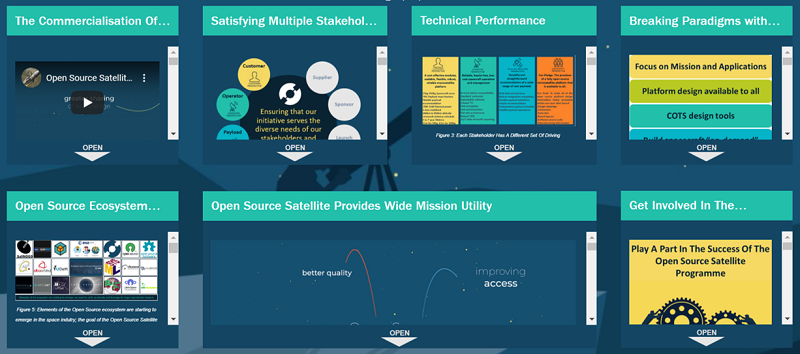The springboard for a diversity of commercially-sustainable missions
Open Source Satellite: The springboard for a diversity of commercially-sustainable missions, applications and services
The Open Source Satellite Programme team was invited to deliver two presentations at IAC 2019; Dr. John Paffett presented to a group of international engineers who were interested to learn more about the Open Source Satellite Programme and find out how to get involved in the community. Download the Interactive Presentation.

Download the Interactive Presentation
The theme for IAC2019 was “SPACE: The Power of the Past, the Promise of the Future”, the influence for the development of a technical programme that reflected the diversity of disciplines within space.
The Open Source Satellite Programme: Developing an Innovative, low-cost, generic microsatellite platform to advance new mission ideas from theoretical possibility to commercially-sustainable reality
Since the Apollo era we have witnessed increasing commercialisation of the space industry. However, increasing efficiencies in high-volume commercial satellite production has not significantly increased access to space for the global community. Until the barriers to affordable, performant satellite platforms are removed it will be difficult for space to be fully democratised in coming decades. There exists a need for a truly commoditised, flexible satellite platform that can be used as the springboard for a diversity of missions and is affordable to manufacture in low volumes. We have instigated a programme to develop an innovative, fully Open Source, flexible microsatellite platform to satisfy this unmet need. The Open Source Satellite Platform is an adaptable, low-cost multipurpose system, offering Microsatellite performance at a Cubesat price.
The enhanced price-performance point of the system, and our pledge to provide free, unrestricted access to the design will stimulate new commercially-viable missions in LEO, MEO, GEO and interplanetary space. The Open Source Satellite Platform is being developed using COTS parts, processes and tools, using an Open Source approach, to increase community collaboration and continuous improvement, creating an efficient, fail-safe, performant, capable, modular and robust microsatellite. It can be tailored for different missions, upgraded and configured after launch and operate with multiple ground networks.

Dr. John Paffett, presenting at IAC2019
The Open Source Satellite baseline architecture and design is generic, yet flexible and capable, enabling a diversity of missions and applications: Launch mass 25kg to 250kg; >70% payload mass fraction; Payload volume 600x600x450mm; Payload power 10W to 1kW; 3-axis stabilised; adaptable pointing knowledge, control and agility; orbit 400km to 850km; 5-7-year lifetime; <14-month schedule; and prices of USD1m for a 50kg variant, GBP1m for a 100kg variant, even for single or low quantities of satellites.
This Interactive Presentation illustrates the wide potential utility of the design by describing two distinct examples of how the same Open Source Satellite Platform system can be used to address two different mission scenarios, which are in active development and planned for launch readiness in the early 2020s: a low-cost Earth observation mission and a highly-optimised, integrated spacecraft-launch vehicle configuration. The presentation describes the longer-term roadmap, the improvements in system performance, and enhanced mission utility planned for future platform variants. The presentation also discusses how the Open Source approach underpins the goal of making this low-cost generic system as accessible as possible, creating positive conditions for the next steps in innovative small satellite missions.
IAC 2019 Session Details: Symposium B4 – 26th IAA Symposium on Small Satellite Missions
The International Academy of Astronautics (IAA) Symposium on Small Satellite Missions is focused on recent advances in small satellite class missions weighing much less than 1000kg, addressing needs in government, commerce, or academia. Papers focused on how microsatellites, nanosatellites, cubesats and small and “megaconstellations” amongst others enable valuable results for the mission end-user. Papers should benefit the wider smallsat community and demonstrate a degree of ingenuity and innovation in small satellite utilisation, design, manufacture and/or engineering.
Papers reported on important lessons-learned, describe notable missions in the planning stages, or include topics that demonstrate the value of small satellites and their constellations, their applications.
Sessions covered the role that small satellites can play in developing space nations, science, exploration, “NewSpace”, communications and Earth Observation. Sessions also cover cost-effective operations, affordable and reliable access to space through launch, and emerging and promising smallsat technologies and techniques.
Paper code: IAC-19,B4,IP,10,x50801
What are your thoughts about the barriers to truly democratising space?
Email us or let us know in the Comments section below.
www.opensourcesatellite.org exists to create an environment that supports and enables
entrepreneurial and innovative thinking, with the aim of taking the next step in small satellite capabilities.
Join our community, follow us and be part of the journey!
COMMENT
Thank you for your comment